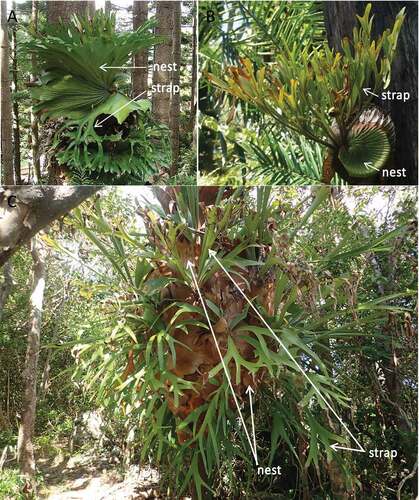Figures & data
Figure 1. Growth form diversity in Platycerium ferns. (a) P. superbum displaying Type I morphology: fan-shaped nest fronds that collect rainwater and pendulant strap fronds that reduce biomechanical demands on root systems (photo credit: Tatiana Gerus). (b) P. ridleyi displaying Type II morphology: clasping nest fronds that promote structural support and water storage, and erect strap fronds that collect rainwater (photo credit: Ganges Lim). (c) P. bifurcatum, a colonial species that exhibits components of both growth forms (photo credit: Ian Hutton). Individuals at the top of colonies produce fan-shaped nest fronds and erect strap fronds, both of which appear adapted to collect rainwater. Individuals at the bottom produce both clasping nest fronds and pendulant strap fronds, which appear to promote structural support. Therefore, colonial living appears to promote several unique combinations of frond forms that are not observed in solitary species

Figure 2. Changes in frond angles within a Platycerium bifurcatum colony. The angle of strap fronds was measured on the youngest, fully mature strap frond from 19 individuals within a single colony growing in the glasshouse in the Wellington Botanical Garden. Frond angles, which ranged from 0° when pointed downwards to 180° when pointed upwards (y-axis), increased with their height above the base of the colony (x-axis). Best fit line from linear regression is shown along with the 95% confidence interval (n = 19, t = 7.513, p < .001). Vertically orientated fronds positioned at the tops of colonies may facilitated water capture and transport to individuals below [c.f. Citation8]
![Figure 2. Changes in frond angles within a Platycerium bifurcatum colony. The angle of strap fronds was measured on the youngest, fully mature strap frond from 19 individuals within a single colony growing in the glasshouse in the Wellington Botanical Garden. Frond angles, which ranged from 0° when pointed downwards to 180° when pointed upwards (y-axis), increased with their height above the base of the colony (x-axis). Best fit line from linear regression is shown along with the 95% confidence interval (n = 19, t = 7.513, p < .001). Vertically orientated fronds positioned at the tops of colonies may facilitated water capture and transport to individuals below [c.f. Citation8]](/cms/asset/8e01ed83-1634-4120-967d-c2d07c69602e/kpsb_a_1961063_f0002_b.gif)
